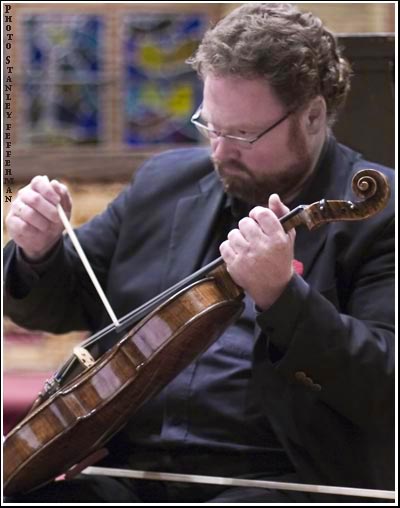 |
| Continuum Contemporary Music
In the Asylum: New Works by five striking visionaries
|
| November 6, 2005 • Music Gallery • Toronto |
|
|
Twice On The Pipes
by Stanley Fefferman |
| Rodney Sharman’s charming Moments is a series of five related miniatures for chamber ensemble. These delicate tissues of sound are occasional pieces inspired by feelings for artists such as Mozart, Kaija Saariaho, and Dan Kelly. The fifth one, described as ‘both minimal and erotic’ was quite magical, suggesting the colours and textures of time: the duration of a plucked string, the repetition of the flow of breath over reed, brought to mind moments flowing or shrill, moments in and out of harmony, solitary moments, moments of boredom and moments of excitement. |
| One of the challenges of contemporary music is to explore “how conventional techniques of performance can be modified so that new types of sounds emerge” (Jennifer Walshe). Ms. Walshe’s piece “unbreakable line_hinged waist” (2002) for flute, clarinet, oboe, strings and percussion is “ loosely based on recordings [she] made of the heating system in [her] apartment in Chicago”. Heating system noises were simulated by banging on a can (of Fresca), strings played with chopsticks, or the bow applied to the body rather than to the strings, the pianist drumming fingers on the frame of the piano or thumping on the pedals without touching the keys. If the adjectival form of the word ‘music’ is ‘musical’, then the adjectival form of sounds “lacking any predictable order or plan would be ‘stochastical’. The audience received this particular experiment in stochasticity with enthusiasm once they realized it was actually over. |
|
 |
|
Andrew Hamilton’s frank ohara on the phone (2003) memorializing the famed New York poet is inspired by a photograph of O’Hara talking on the phone. It involves shouting repetitions of the letter ‘f’, and spelling of words like t-h-e, and r-a-m-p-a-n-t. Generally, the piece has a jumpy, syncopated, staccato beat based on the repetition of a seven-note phrase ( da-da, da-da-da da-da). Urban music still, with the pulse of Manhattan traffic mixed with a rampant circus, and a refreshing change from the previous Chicago radiator.
The most enjoyable piece of the evening was Allison Cameron’s Pliny (2005). It is inspired by a Borges story of a man who cannot forget a single detail of any event, person or thing and loses his ability to function because his world is nothing but details. The piece has a lovely melancholy Debussyesque quality evoked by slow and prolonged resonances of pizzicato cello, gongs, and thin breathy reeds. Ms. Cameron introduces some novel sounds, such as the buzz of thin chains draped on the keys of a vibraphone. Nonetheless, it occurs that no matter how ‘unmusical’ the sound source, most moods resolve into evocations of a time of day or a season. In this case, Pliny develops a winter morning mood of sunshine on crystalline icicles, the melt, the slow dripping and the flow—a peaceful mood that is reflective, wistful and rich.
In The Asylum (2000) by Gerald Barry, scored for violin, cello and piano, is a passionate, tumultuous piece, noisy and disturbed. It appears to be built on the idea of repetitive variations of passages that begin meekly, rise to a dark tumult, end abruptly, and resume a meek beginning. Since the guest curators Juliet Palmer and James Rolfe chose In The Asylum as the title piece for the first of Continuum’s 20th Anniversary Season concerts, one is tempted to ponder its broader applicability to situations. Daniel Warren, the guest conductor, worked transparently with this dauntingly eclectic program.
|
|
|
|
|
|
|


